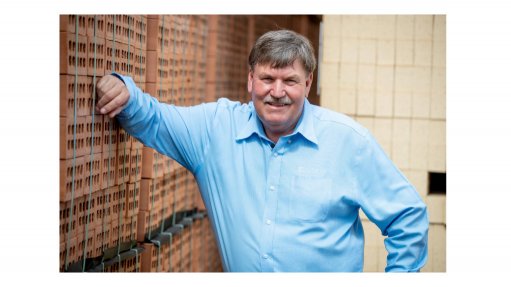
NICK BOOTH As a result of Corobrik accessing coal at its mine, the Department of Mineral Resources and Energy requested Corobrik to apply for a coal mining licence to mine the coal and have it removed. Booth adds that Corobrik has no intention to sell coal and intends to remain a brick maker
Clay brick and paver maker Corobrik reports that it has no intention of entering into the coal mining sector, despite its application to mine the commodity at its Centurion-based Rietvlei mine and brick-making plant.
The company operates a clay mining operation near the ecologically-sensitive Rietvlei Nature Reserve and concerns were raised by the nearby community, reserve stakeholders and visitors, when it came to their attention that Corobrik intended to apply for a licence to mine coal at its existing clay mine.
However, Corobrik CEO Nick Booth states that while its Rietvlei operation is a traditional opencast clay mining setup used by all brick makers, the company is aware of the presence of coal within the clay deposit, and that as the clay mine progresses – having been opened in 1983 – coal has increasingly been accessed as part of the overburden encountered at the deposit.
“We knew there was coal in the quarry, as we are constantly measuring our clay reserves and constantly planning the next segment of our clay-mining operation,” he explains.
Booth adds that drilling ahead of the face to obtain an exact understanding of where the clay deposits were situated, resulted in the discovery of coal.
“What you do not always pick up from a drilling programme is the quantity, or the thickness, of the different layers of material such as clay and coal. Only when you actually start to work the face backwards do you begin to see the delimitations of each material layer,” notes Booth.
Corobrik has consistently mined three different types of clay at Rietvlei, to the point where the presence of a coal overburden has now become a factor in terms of its thickness in the surrounding clay being mined.
As a result of Corobrik accessing coal at its mine, the DMRE subsequently requested Corobrik to officially apply for a coal mining licence to mine the coal and have it removed, with Booth adding that Corobrik has no intention to sell coal and intends to remain a brick maker, and be recognised as a miner of clay and not coal.
As a result of increasingly accessing coal, Corobrik applied to the Department of Mineral Resources and Energy (DMRE) as early as 2022 to obtain a licence to mine the coal so as to remove it and secure ongoing access to the clay reserves present.
The clay layer is sandwiched between two layers of coal, which has necessitated coal being stockpiled at the quarry in the meantime.
“Our commercial consideration is that the coal is now overlying the carbonaceous clay deposits we need to utilise for our brickmaking operation at Rietvlei,” says Booth.
As a result of maintaining its focus on clay mining, he highlights that a contractor will be appointed to mine the coal overburden and ensure its proper removal and disposal.
In this regard, Corobrik notes that it is vital to remove the coal stockpile owing to the environmental risk from contamination and the potential for spontaneous combustion if the coal stockpile becomes too big.
“We have no long-term plan around the coal. It is really a case of removing what is in our way so we can mine the clay to our best advantage in terms of running the brick factory. The coal is actually an obstacle at this point,” says Booth.
“It is a complex issue,” notes Booth, adding that there are already coal mining operations on the same watercourse in the Rietvlei area.
Further, he also points out that while estimates for the size of the coal resource at Rietvlei point to the commodity being accessed for the next seven years (based on current mining performance), Corobrik intends to mine clay for the next 35 years. “This means that our Rietvlei factory will continue to be a viable clay brick making factory until at least 2050,” concludes Booth.